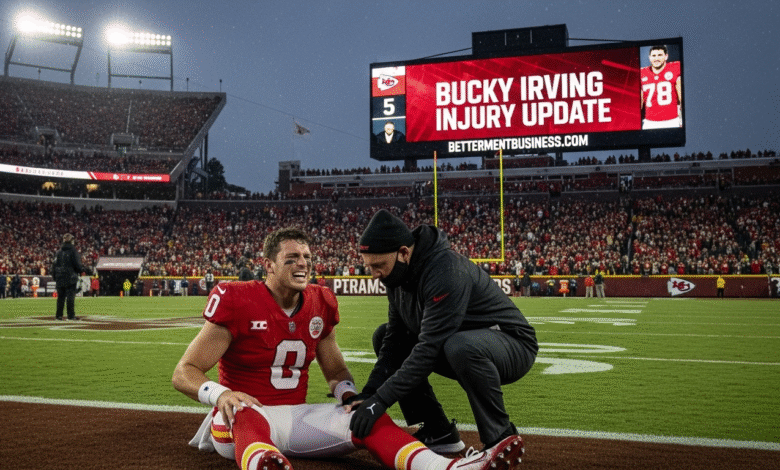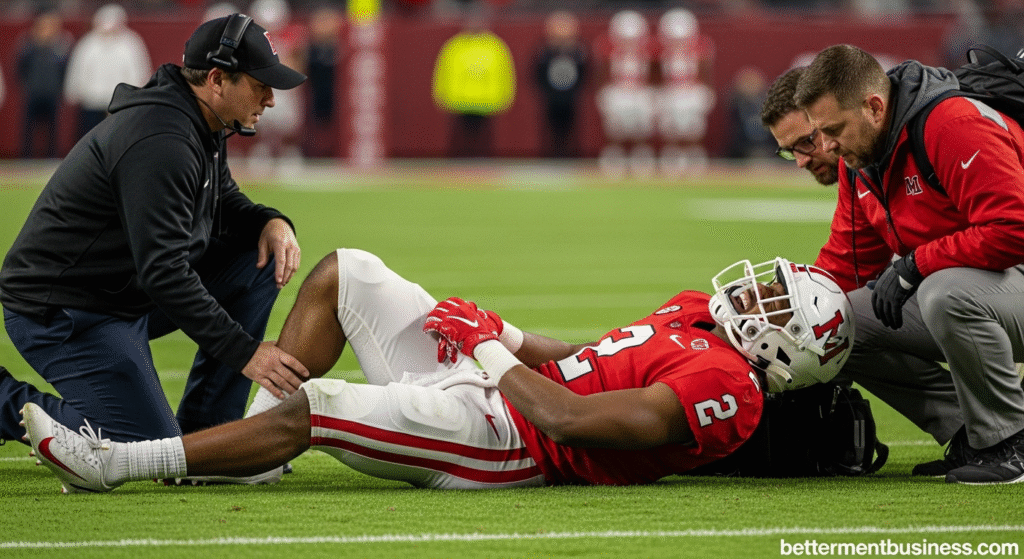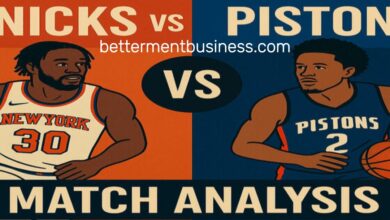Understanding Bucky Irving Injury: Impact and Future Prospects

Introduction to Bucky Irving
Bucky Irving is a prominent figure in collegiate football, known for his exceptional agility and playmaking ability. Born on November 16, 2002, in the United States, he displayed remarkable athletic talents from a young age. As a running back, Irving has showcased a unique blend of speed, vision, and elusiveness that has garnered attention from fans and coaches alike. His journey in football began at a young age when he played in local youth leagues, eventually leading him to high school competitions, where he earned accolades for his performance on the field.
Irving’s college career took off at the University of Oregon, where he made an immediate impact as a freshman. During his time with the Ducks, he saw significant playing time and quickly established himself as a key player in the team’s offense. Known for his ability to break tackles and find gaps in the defense, Bucky’s contributions helped Oregon achieve notable success during his tenure. His performances not only solidified his role as a starting running back but also placed him on the radar of NFL scouts who recognized his potential to excel at the professional level.
Despite his impressive skills and collegiate success, Bucky Irving’s journey has not been without challenges. Injuries can hamper a player’s performance and development, and maintaining peak physical condition is crucial for success in football. The recent discussions surrounding the bucky irving injury have raised concerns about his immediate future and the impact it may have on his burgeoning career. As conversations unfold regarding his recovery and return to the field, it is essential to understand both his background as a player and the significance of his injury on the prospects for his future in football.
Circumstances Surrounding the Injury
Bucky Irving injury unfolded during a critical matchup in the latter stages of the season, a game that had significant playoff implications for his team. As the clock ticked down in the third quarter, he was involved in a high-stakes play when he attempted to evade a defender after receiving a handoff. In the ensuing split-second, Irving made a swift lateral move that appeared to put considerable strain on his lower body. The moment was tense; spectators held their breath as he went down, unable to get back up immediately.
The impact of the injury resonated throughout the stadium, wandering eyes of teammates and coaches reflecting concern. Athletes and fans alike watched as medical personnel rushed to attend to Irving, who remained on the ground for a prolonged period. The team’s head coach, who has often emphasized the importance of player safety, expressed immediate worry regarding the severity of the incident during post-game comments. This sentiment was echoed throughout the locker room, as his teammates gathered around him, visibly shaken by the unexpected turn of events.
As further details emerged after the game, it became evident that the incident was not just a routine injury, but one that could have long-term ramifications for Irving’s career. Initial medical assessments suggested potential damage to his ligaments, though definitive diagnoses would require further imaging. The atmosphere surrounding the team grew somber, transitioning from hope and competitiveness to concern for a teammate’s well-being. Observers remarked on how pivotal Irving had been for the team’s offensive strategy, making his injury not only a personal setback but also a significant challenge for the squad’s overall performance as they approached critical games. Bucky Irving injury incident has remained at the forefront of discussions in sports circles, raising questions about recovery trajectories and future implications.
Type of Injury Sustained
Bucky Irving injury has been diagnosed as a significant lower extremity ailment, specifically a soft tissue injury that has raised concerns regarding both the severity and the impact on his athletic performance. Medical examinations revealed that he sustained damage to the ligaments in his knee, a condition often referred to in clinical terms as a knee sprain. This particular type of injury is categorized into varying grades based on severity; Bucky’s injury has been assessed as a Grade II sprain, indicating partial tearing of the ligament. This diagnosis typically suggests a moderate level of joint instability and inflammation, which can lead to considerable pain and swelling.
The ramifications of sustaining a knee sprain can be profound for an athlete. Such injuries often result in a decreased range of motion and loss of strength in the affected limb, severely impacting an athlete’s ability to perform at high levels. In Bucky Irving’s case, the injury has not only halted his time on the field but has also necessitated a structured rehabilitation program to regain functional capability. This kind of injury can disrupt an athlete’s rhythm, as recovery may involve both physical therapy and an extended period of rest, ultimately influencing their preparation and performance levels once they return to play.
Considering the typical recovery timeline for Grade II knee sprains ranges from a few weeks to several months, the implications for Bucky Irving’s upcoming season are substantial. Athletes recovering from similar injuries often confront challenges in re-establishing the agility and strength required for rigorous competition. Thus, the athletic community will be attentively monitoring Bucky’s recovery progress to gauge his future prospects within the sport.
Initial Recovery Process
Following the bucky irving injury, a multi-faceted recovery process commenced immediately to address both the physical and psychological aspects of healing. Initially, medical professionals conducted thorough evaluations, including imaging studies, to ascertain the extent of the injury. This diagnostic phase is critical in forming a comprehensive treatment plan. Based on the analysis, the appropriate medical interventions were determined, which may have included immobilization, pain management strategies, and anti-inflammatory medications to mitigate swelling and discomfort.
In cases where the injury presented severe complications, surgical intervention may have been deemed necessary. Such procedures typically aim to restore functionality and stabilize the affected area. If Bucky Irving underwent surgery, the operation would have involved repairing damaged ligaments or tendons, or, in some instances, realigning bones. Post-surgery, a crucial recovery phase begins, where medical personnel monitor the patient closely for any signs of complications, ensuring that the healing process is progressing as expected.
The estimated timeline for recovery varies widely depending on the nature and severity of the injury. For many sports-related issues, a typical recovery can span from several weeks to multiple months. Early stages of rehabilitation generally focus on gentle range-of-motion exercises, which are essential in preventing stiffness and promoting blood circulation in the affected area. Gradually, the rehabilitation process will expand to include strength-building exercises targeted at increasing resilience and functionality. Bucky Irving’s medical team will likely implement a customized rehabilitation plan to facilitate his return to peak performance, ensuring that every step is carefully monitored and adjusted as necessary to achieve optimal recovery outcomes.
Expert Opinions and Analysis
The recent Bucky Irving Injury has sparked considerable discussion among sports medicine experts, analysts, and fans alike, shedding light on its potential ramifications. Notably, Dr. Emily Thompson, a leading sports physician, remarked, “Injuries such as the one Irvings sustained can be complex and require a tailored rehabilitation approach. They often involve not just physical recovery but also mental fortitude.” Her insight underscores the multifaceted nature of recovery from athletic injuries, emphasizing the importance of both physical healing and psychological resilience.
Similarly, sports rehabilitation specialist, Dr. Michael Roberts, provided an analysis of the expected timeline for recovery. He stated, “With proper rehabilitation, players like Bucky Irving can return to their peak performance levels, though this often takes considerable time and dedication.” This assessment suggests that while the road to recovery may be long, the potential for a successful comeback remains viable, contingent upon adherence to rehabilitation protocols. His comments also highlight the typical recovery period following similar injuries, which often varies based on the individual athlete’s circumstances and the severity of the injury.
Furthermore, renowned sports analyst, Sarah Johnson, shared her perspective on the implications of Irving’s injury for the team dynamics. “Bucky’s absence could alter team strategies since his playing style is integral to their offensive schemes. How the team adapts in his absence will be critical,” she explained. This commentary reveals the broader impact of Bucky Irving injury not just on his personal career but also on the team’s performance and strategies moving forward.
In light of these expert insights, it is clear that Bucky Irving injury is not merely a personal hurdle but a circumstance with far-reaching effects on various levels, requiring a comprehensive understanding and approach to recovery. The journey ahead will necessitate a collaborative effort from medical professionals, coaches, and Irving himself.

Comparative Analysis with Similar Injuries
Understanding the ramifications of Bucky Irving injury requires a look at similar injuries sustained by professional athletes across various sports. A significant aspect to consider is the nature of the injury itself and how it correlates with the recovery trajectories of others who have faced comparable challenges. For instance, running backs in American football often encounter injuries like hamstring strains, which can share symptoms and recovery timelines with Irving’s condition. These injuries typically require a multifaceted rehabilitation approach, emphasizing strength training and gradual return to the field.
One notable case is that of former NFL star Adrian Peterson, who faced a devastating knee injury early in his career. Peterson’s recovery involved intense physical therapy and strength conditioning, resulting in a remarkable return to peak performance levels. Comparisons can be drawn to Irving’s situation, as both athletes rely on explosive speed and agility. While Peterson’s case is more severe, studying his recovery can provide insights into the potential outcomes for Bucky. The psychological aspect of recovery also plays a significant role; accessing mental resilience during rehabilitation can influence the overall journey back to the sport.
Furthermore, basketball players frequently deal with ankle sprains, which, while they may not directly align with Bucky Irving injury, present similar recovery dynamics. Players like Derrick Rose have faced repeated setbacks due to ankle injuries, ultimately impacting their performance. An examination of these cases indicates that the pressure and expectations placed on these athletes play a crucial role in their recovery success. In Irving’s context, understanding these dynamics will be essential in predicting not just his return to play but also how effectively he can perform post-injury.
Impact on Team Performance
The injury sustained by Bucky Irving has had significant repercussions on the overall performance of his team. As a pivotal player, Irving not only contributes through his notable skills on the field, but he also plays a crucial role in maintaining team morale and cohesion. His absence is likely to create a notable void that cannot be easily filled, leading to strategic shifts as the team adapts to his loss.
In terms of current standings, the team may experience an increase in pressure as they seek to compensate for the lack of performance that Irving typically provides. This can manifest as a series of adjustments in player positions, roles, and strategies during games. Without their star player, the remaining members must elevate their performance levels, potentially altering their dynamic and overall chemistry on the field. The coaches will need to assess which players can step up, particularly in key offensive and defensive roles that Irving excelled in.
Insights from the coaching staff indicate that creating a modified game plan may be a necessity. This might involve utilizing alternative formations or tactical approaches that better suit the strengths of the available roster. Coaches may also emphasize developing younger or less experienced players to ensure that the team maintains competitiveness despite the setback. As the season progresses and depending on the timeline of Irving’s recovery, these adjustments will require continuous evaluation to determine their effectiveness.
The psychological impact of losing a notable player like Bucky Irving is a factor that cannot be overlooked. The team must navigate the challenge of maintaining focus and resilience in the face of adversity, which is essential for their ability to perform effectively without him. Overall, the full impact of his injury will unfold over time as the team strives to find its footing in a competitive landscape.
Bucky Irving’s Future Prospects
The future prospects for Bucky Irving following his injury are a significant topic of discussion among fans, analysts, and team management. The road to recovery from such an injury can often shape an athlete’s career trajectory. However, optimism is essential in these situations, and many believe that Irving possesses the tenacity and skills necessary for a successful return. Historically, athletes with similar injuries have demonstrated remarkable resilience, and Irving’s case may prove to be no different.
One of the critical factors influencing Bucky Irving’s future will be the rehabilitation process. Proper care and a dedicated training regimen will heavily impact his recovery timeline. The extent of the injury, along with his physical conditioning and emotional strength, will play a significant role in determining when he can return to the field. Moreover, during recovery, it will be vital for Irving to focus on setting achievable milestones and goals that can serve as benchmarks for his progress. This approach not only ensures a structured recovery but also helps maintain a positive mindset.
Fan expectations are another crucial aspect of Irving’s future. Supporters are likely eager to see him back in action and contributing to his team’s success. Thus, it is important for both Irving and his management to communicate realistic timelines and anticipated goals for his return. This transparency can foster trust and maintain interest among fans. In instances like these, facing adversity can often propel an athlete to new heights, and Bucky Irving has a unique opportunity to thrive post-injury.
In conclusion, while the road might be challenging, with a dedicated recovery plan and support from fans and the organization, Bucky Irving’s future prospects remain bright. By prioritizing rehabilitation and setting goals, Irving can work towards making a successful return to the sport he loves.
Conclusion and Final Thoughts
In the world of professional sports, injuries can have significant implications not only for the athletes themselves but also for their teams and supporters. Bucky Irving injury serves as a stark reminder of the physical toll that competitive athletics can impose. Understanding the nature and impact of sports injuries is crucial for fans and teammates alike, as it fosters empathy and awareness of the challenges athletes face on their path to recovery.
Throughout this article, we explored the specifics surrounding Bucky Irving injury, detailing its potential implications on his performance and the overall dynamics of his team. This understanding is essential as it allows fans to appreciate the dedication and effort athletes demonstrate even during such tough circumstances. The recovery process is often arduous, requiring immense mental and physical resilience. Athletes like Bucky Irving must navigate the complexities of rehabilitation and training to return to their peak performance levels.
As Bucky Irving embarks on his journey toward recovery, it is vital for fans and teammates to rally around him. Their support plays an integral role in the emotional and psychological aspects of recovery. It is important to recognize that while the road ahead may be challenging, resilience is a powerful attribute that many athletes possess. Encouraging words and unwavering support can make a significant difference, fostering a positive environment that promotes healing.
In summary, understanding Bucky Irving injury not only highlights the difficulties faced by professional athletes but also underscores the critical role of community support during recovery. Fans and teammates alike are encouraged to remain optimistic and supportive as Bucky navigates this challenging period, ultimately looking forward to his return to the field.
Also readc on bettermentbusiness.com



